The Explorers
Humanities and social sciences PhD students cross traditional boundaries, break new ground
This is the sixth article in a series about the University of Pittsburgh’s programs in graduate and professional education.
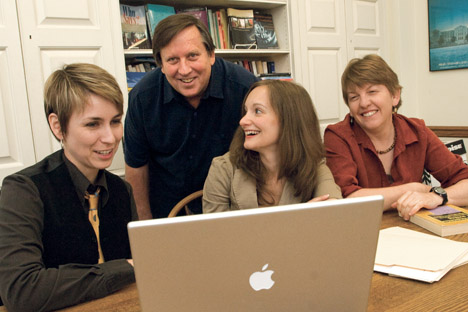
David Bartholomae (standing), professor and chair of Pitt’s English department, says the department’s expanded vision has helped transform the field of English. Pitt graduate students in the Department of English pictured with Bartholomae are (from left) Katherine Kidd, Anna Redcay, and Helen Gerhardt.
Jen Waldron, an assistant professor in Pitt’s English department, recently taught a graduate seminar called “Word and Image.” Waldron, director of Pitt’s Medieval and Renaissance Studies Program, is a scholar of Elizabethan and Jacobean drama. But the enrollment sheet for the seminar included students doing graduate work in creative writing, art history, French, English literature, and film studies. They were all interested in similar questions: How are words and images produced and received? What do they say about the world in which they were created?
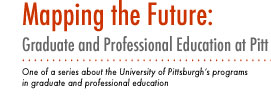 “We are all interested in how a message changes when it’s translated into a different medium and how various modes of representation interact with one another in particular cultural contexts,” Waldron says.
“We are all interested in how a message changes when it’s translated into a different medium and how various modes of representation interact with one another in particular cultural contexts,” Waldron says.
Waldron’s colleague in the English department, Susan Z. Andrade, is a scholar of African and Caribbean literature, with a special interest in the African novel. Andrade sits on the dissertation committee of a PhD candidate in Pitt’s Department of Germanic Languages and Literatures who is writing about Romanian émigré literature in Germany. In Andrade’s work on the African novel, she asks a question similar to the PhD candidate on whose committee she sits: What do the content and form of these literatures tell us about the society that created them?
For his PhD dissertation in history, Niklas Frykman spent much of the past two years traveling throughout Europe and visiting Naval archives. He visited six countries and six national archives looking for information on late-18th-century mutinies. Scouring source material written in five different languages—Danish, Dutch, Swedish, English, and French—he was trying to illuminate the relationship between the egalitarian ideals of the French Revolution and the sudden rash of mutinies in the Atlantic.
None of these scenarios would have been likely a generation ago, when graduate students were expected to master a more narrowly defined discipline. English students needed to know the prescribed canon of literary works and, generally speaking, didn’t have much to do with religious studies, political science, or anthropology. History PhDs wrote dissertations on one country or another. Not six.
Pitt’s graduate programs in the humanities and social sciences now allow—even encourage—students to pursue broader interests. They take more seminars outside their own departments and are learning to straddle the boundaries of disciplines, fields, and specialties in an effort to chart new scholarly terrain.
Beyond a Particular Time and Space
The turn toward cross-fertilizing initiatives is happening on a number of different levels. Within individual departments, some graduate programs have been revamped to incorporate these initiatives.
“The best programs are those in which academic leadership is always rethinking the direction of scholarship,” says Pitt Provost and Senior Vice Chancellor James V. Maher. “Department chairs and faculty are trying to broaden their students’ exposure in a systematic way. Today they see their work in a broader discourse.”
Scholarship in the humanities, for example, has traditionally been defined by time and space—say, the Victorian novel or antebellum plantation life. Doctoral students will always be expected to master their subfields, but departments are increasingly interested in producing scholars who can address a broader array of questions.
As a result, the study of a particular time and place is being enriched by an awareness of what’s going on in other times and places. Graduate programs are not abandoning the traditional time-and-place model of scholarship, Maher and others say, but rather expanding it so that when students graduate, they are able to place their own areas of study within a much broader context.
In addition, Pitt’s Universitywide certificate programs—Women’s Studies, Film Studies, and component programs within the University Center for International Studies—help PhD students explore intellectual frameworks outside their “home” departments. Thus, the natural intellectual curiosity of individual students and scholars serves as a constant source of innovation within the humanities.
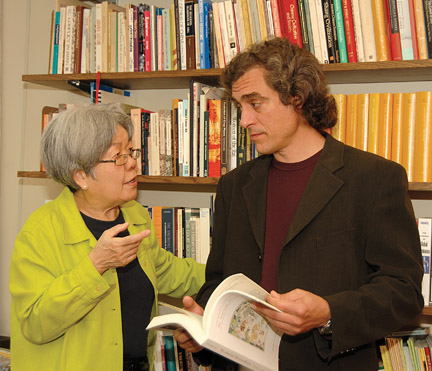
Evelyn Rawski, University Professor of History and the department chair, and history professor Alejandro de la Fuente, director of the department’s graduate studies, helped institute deep changes in the department’s graduate program to provide a more rounded education. As of 2003, graduate students in history are required to study one of several thematic, transnational fields.
Rethinking and Reconfiguring Programs
Two examples of this kind of cross-curricular thinking can be found in Pitt’s English and history departments, both of which were selected to participate in the Carnegie Initiative on the Doctorate, a national program that seeks to improve doctoral education.
“We were asked to evaluate what we do and, more importantly, why we do it,” says Evelyn Rawski, University Professor of History and the department chair. “The initiative asked us why we’re requiring students to do the things we do and then to simplify the process, to better define the academic mission.”
As a result of this introspection, the history department began initiating deep changes in its graduate program. In 2003, it began requiring graduate students to study one of a handful of thematic, transnational fields. A good example of this is Atlantic History. Now, instead of just studying 17th-century New England history, for instance, students would also be expected to understand important political and social changes in Western Europe at that time, the rise of the West African slave trade and the settlement of the West Indies.
Racism provides an excellent example of this, says history professor Alejandro de la Fuente, director of the department’s graduate studies. “As a corpus of ideas and policies, racism can be studied from the framework of the nation-state. But if you look at it outside of one region or nation-state, you discover many of these ideas have traveled around the world and have been used and applied in different areas. They become part of a larger trend.”
The department paired up professors from different subdisciplines to design and teach courses in thematic topics. In the course Text and Context, for instance, a scholar specializing in Asian studies and one specializing in European studies devised a syllabus that showed the evolution of words and ideas from Ancient Greece to early China, Imperial Japan, and 17th-century Europe.
The English department was no stranger to self-examination when it took part in the Carnegie Initiative. The PhD program had already undergone a transformation in the 1990s that included a name change. Doctoral students now earn PhDs in critical and cultural studies, not English. The name change reflected a shift that included the study of nontraditional texts, like films, as well as a different way of thinking about literature.
“No one can imagine that film hasn’t had an effect on the way people think of narrative,” says David Bartholomae, professor and chair of the English department. “When you change the focus to critical and cultural studies, you begin to acknowledge that text works in places that extend beyond the page. You can ask questions like, ‘What do people see, read, watch? What’s the cultural work of the novel with respect to 9/11?’”
Still, participating in the Carnegie Initiative on the Doctorate helped show some of the program’s shortcomings, Bartholomae says. Faculty worried students were becoming too specialized. The department wanted to make sure students had a more balanced training. So the department expanded students’ reading and project lists to give them a more comprehensive background.
“If a student entering the job market was writing a dissertation on, say, [20th-century American novelist] Thomas Pynchon and the theory of the nation or American imperialism, we would want someone looking at that student’s CV to say, ‘Oh, this person can teach our 20th-Century Novel course or our Survey of American Literature,’” Bartholomae says.
The changes over the past 15 years have catapulted the program into national prominence. Pitt’s English department now ranks in the top fifth of all doctoral programs, according to the National Research Council. “This was a radical change,” says Bartholomae. “We were doing the kinds of work in a number of different areas that were catching people’s attention. The thinking was, if the field of English was changing, we were leading the change.”
Pitt’s Department of the History of Art and Architecture also encourages its students to become proficient in areas outside of their traditional focus—in this case, regional.
“The key is to situate your research within a question that is of interest outside the particular region or area you’re studying, but also across cultures and times,” says Katheryn Linduff, a professor of East Asian art history and chair of the department. “We want to be able to think about the really big questions: What’s the function of a portrait? How do architectural movements travel to other countries? We’re positioning our students to do more broadly based cross-cultural work.”
Students in the history of art and architecture program are researching a wide array of materials, from Chinese mortuary art and German churches in Poland and Jerusalem to 19th-century French photography.
According to Linduff, the increasingly global nature of daily life with the advent of the Internet and instant worldwide communication makes the interdisciplinary approach crucial to understanding any field. In addition, the discipline is undergoing a transformation that necessitates a better understanding of other disciplines and connections between cultures.
“We’re moving away from the notion that everything important happens only in one place. We’re moving past just looking at Paris in the 19th century,” Linduff says. “There’s an increasing awareness that creativity can happen anywhere, and that interconnectedness isn’t just possible—it’s likely. It’s part of a way of looking at art that’s not just focused on a single individual ‘great artist’ but on the process of creativity.”
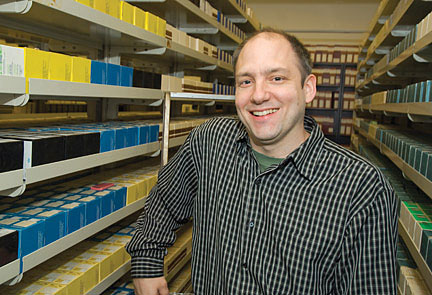
Eric Kimball, a doctoral student in the Department of History, is finishing his dissertation on trade between the New England colonies and the Caribbean. Setting early America within the context of Atlantic history makes for a richer understanding of the discipline, he says. Kimball is photographed in the microfilms section of the Hillman Library, which has collections he used in his research, including naval office shipping records that record trade entering and leaving the colonies, Parliamentary reports and testimony, the American slave trade collection, and West Indian slave plantation records.
Illuminating the Questions
Changes in Pitt’s English and history departments have attracted a diverse group of young scholars. English PhD students study everything from Arthurian texts to war movies to multiplayer online video games.
The essential questions of the disciplines unite the research: How are narratives constructed? What impact do these works have on an audience? What can the texts tell us about the world in which they were created?
The interdisciplinary nature of the Pitt English department attracted Richard Parent to the University. “When I was looking at PhD programs, I made a list of all the classes I could take at the places that accepted me and gave me funding,” says Parent, who received his Pitt PhD in 2005 and is now an assistant professor at the University of Vermont. “The list at Pitt was about five times longer than the lists at other schools.” Parent took courses in the Departments of Religious Studies, Communication, and Philosophy, and he wrote his dissertation on how online and interactive texts affect the way we read.
Parent feels working with a diverse group of scholars—his committee consisted of an expert each in reading, composition, and interpretation—benefited him, especially when it came to explaining his research to hiring committees with little exposure to “digital studies.” “I was lucky, because my committee kept forcing me to be as clear as possible and make sure that what I was writing was understandable to as many people as possible.”
The history department’s turn toward transnational themes has aided students of American history, Rawski says. “Now our Americanists have expertise in more than just their regional areas.”
Eric Kimball, who is finishing his dissertation on trade between the New England colonies and the Caribbean, says setting early America within the context of Atlantic history makes for a richer understanding of the salient questions of the discipline.
“When you study Atlantic history, you can ask questions like, ‘When the 13 colonies decided to declare their independence, why did the other colonies decide not to?’ ‘Why didn’t Canada and the Caribbean decide to declare their independence, too?’” says Kimball, who will be an assistant professor of colonial American and Atlantic history at Utah State University in the fall. “You can actually illuminate the questions of why those 13 decided to break away when they did by looking at the era from a transnational perspective.”

Jamie Bono, a PhD student in the English department who studies digital texts and alternate reality games, draws his research from numerous disciplines, including the history of technology, literary criticism, and classic Greek rhetoric. The ability to engineer his own course of study attracted him to Pitt and is what excites him about the work he will do for his dissertation.
A Network of Bridges
Abetting this multidisciplinary approach are the University’s certificate programs, which provide training in areas that straddle the domains of different disciplines—women’s studies, film studies, and international studies, among others.
Getting a certificate in women’s studies exposed Julie Hakim Azzam—an English department student who finished her critical and cultural studies PhD on postcolonial literature and gender in fall 2007—to works of sociology, anthropology, political science, and history.
“Women’s studies gave me a vocabulary to talk about politics or history in literature—something I’d always been interested in but didn’t know how to bring within the scope of literary analysis,” says Hakim Azzam, who teaches women’s studies and literature at Chatham University. “I’d read articles about how political upheavals affected women or the way that culture creates gender and gendered forms of oppression,” she says. “I saw that happening in the novels I was reading but didn’t know how to discuss it. Women’s studies gave me a way to discuss those topics.”
Helping doctoral students understand the regions they are studying is the primary purpose of the University Center for International Studies’ graduate certificate program. Students in the Latin American Studies graduate program, for instance, are required to take courses on Latin America outside of their major. The cross-disciplinary study of a region is crucial, says Kathleen M. DeWalt, a professor of anthropology and public health and director of Pitt’s Center for Latin American Studies (CLAS).
“One of the ways to deepen a student’s understanding of a place is to have a more contextualized view of the region, to place one’s own disciplinary perspective in the context of other disciplines,” says DeWalt. “I encourage all my anthropology students to take Latin American history or politics.”
CLAS is one of five federally designated National Resource Centers at Pitt, and thus among the top few centers of its kind in the nation. The center attracts students from anthropology, business, education, history, Hispanic languages and literatures, and other programs.
In the film studies certificate program, graduate students from different departments study everything from Chinese movie-watching habits in the 1920s to contemporary Black crime films. The program attracts PhD students from the Departments of English, Communication, Slavic Languages and Literatures, and Germanic Languages and Literatures.
“Film by its very nature is interdisciplinary,” says Lucy Fischer, Distinguished Professor of English and Film Studies and director of the Film Studies Program. “The film object itself draws from many different fields—literature, theater, pictorial arts—and we also study a lot of the economic and business aspects of film.”
“Film is our new national literature,” says Tanine Allison, a doctoral student in English and film studies who is writing her dissertation about World War II films. “Film has a huge cultural impact. We need to be able to step back and learn what kinds of images are coming at us and shaping our opinions. If we don’t study it, we’re missing out on a huge part of how our culture works.”
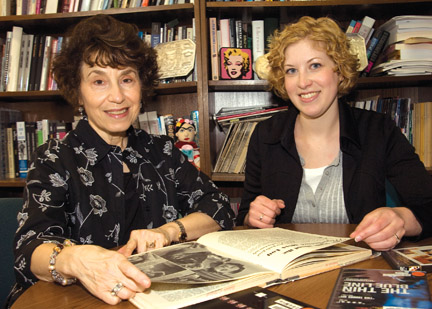
Lucy Fischer (left), Distinguished Professor of English and Film Studies and director of Pitt’s Film Studies Program, says film draws from many fields, including literature, theater, pictorial arts, and even economics and business. Tanine Allison (right), a doctoral student in English and film studies who is writing her dissertation about World War II films, believes that film is our new national literature.
Choose Your Own Adventure
There is an organic aspect to the interest in an interdisciplinary approach. While departments and certificate programs support a cross-fertilizing approach to graduate education, students are the ones who ultimately push their own research across disciplinary boundaries by following questions or phenomena that can’t be understood by using traditional guidelines.
Jamie Bono’s research provides an excellent example. A PhD student in the English department who studies digital texts and alternate reality games, Bono first became interested in the subject while playing the interactive game Majestic, which is a cross between role-playing and a scavenger hunt. Played over the Internet, it uses text messaging and other media. (The Da Vinci Code’s author, Dan Brown, derived some of his ideas for this novel from Majestic). The field of electronic media studies (referred to by some as the New Humanities) is so new there is no canon of texts for Bono to master. He’s had to design much of his course of study, taking classes in the Departments of the History and Philosophy of Science, Communication, and English.
There is one drawback, says Bono: “I get option paralysis.”
There are numerous disciplines for Bono to draw from, including the history of technology, literary criticism, and classic Greek rhetoric (His reading list includes Aristotle and Marshall McLuhan, who predicted the rise of digital culture and penned the phrase “global village” in 1962). To navigate all this, institutional support is key, he says.
“It’s great to have professors who are willing to go along with this and give me a long leash,” says Bono. “The great thing is that working with people who don’t do what I do forces me to talk with people outside of my field about my research.”
The ability to engineer his own course of study is what attracted him to Pitt, and it’s what excites him about the work he will do for his dissertation.
“We have the ability to apply a range of interests and follow theoretical hunches into directions that haven’t already been cordoned off,” Bono says. “We’re building a field from the ground up.”
Making Progress
The results of the revamped programs in the English and history departments have been largely positive. Many entry-level tenure-stream positions require the ability to teach at least two or three different fields, so having that kind of comprehensive knowledge comes in handy for students entering the job market.
The placement rate for history PhDs into tenure-stream positions has increased rapidly, from 45 percent in 2000 (which Professor de la Fuente points out is the average rate for top-30 programs) to 60-70 percent for the last two years. In English, placement of PhDs into tenure-stream positions has increased in the past 10 years along with a dramatic increase in the program’s national profile.
For Rawski, better placement numbers are a reflection of how well these new methods anticipated broader changes in the field. The American Historical Association (AHA), the field’s leading scholarly organization, recently endorsed the cross-disciplinary approach in its report The Education of Historians for the 21st Century. AHA scholars discovered, among their findings in the report, that today’s graduate students “must be prepared to work at the intersection of disciplines, where more and more of the important scholarship and teaching [are] likely to take place in the years to come.”
For Rawski and others, a finding like this is proof that the innovations are keeping Pitt at the leading edge of doctoral education in the humanities and social sciences.
“In the historical scholarship of the next 20 years, people will be looking at broader questions and must have the ability to look at many different sources,” Rawski says. “This is where the field is going. This is where scholarship is going.”
Other Stories From This Issue
On the Freedom Road

Follow a group of Pitt students on the Returning to the Roots of Civil Rights bus tour, a nine-day, 2,300-mile journey crisscrossing five states.
Day 1: The Awakening
Day 2: Deep Impressions
Day 3: Music, Montgomery, and More
Day 4: Looking Back, Looking Forward
Day 5: Learning to Remember
Day 6: The Mountaintop
Day 7: Slavery and Beyond
Day 8: Lessons to Bring Home
Day 9: Final Lessons

